August, 2019

Games Orchids Play: Floral Mimicry

Photos from Fig. 1, Neubig et al., 2012, see text
A: Malpighia glabra, B-F: some apparent floral mimics in the Oncidium alliance, B: Oncidium sotoanum, C: Cyrtochilum edwardii, D: Tolumnia hawkesiana, E: Cyrtochilum ioplocon
One of the recent taxonomic upheavals among the orchids involves the Oncidium alliance. Doug Overstreet gave us an overview of the situation in his talk on "My 10 Favorite Oncidiums" on July 22. In brief, what was left of Odontoglossum after previous upheavals has now, with the approval of the Royal Horticultural Society, been lumped into Oncidium, and a number of species in that enlarged group have been transferred to other, much smaller genera such as Gomesa, Trichocentrum, Zelenkoa, etc. Why was this done? The main reason is that new research, mainly investigations of genetic similarity ("DNA technology"), demonstrated that some species were much more closely related to other genera than to the members of the genus where they had previously resided, provided that DNA sequences can be assumed to be an impartial reflection of true evolutionary relationships. More exactly, the assumption is that DNA mutations are generally random, and for the most part neutral with respect to gene function, and thus not themselves subject to natural selection. The presence of a significant number of apparently random mutations that do not happen to affect the amino acid sequence of any protein, in two different species, tells us that those two species share a common ancestor in some way, because the odds of a number of identical mutations occurring by chance alone in two species simultaneously are extremely remote. When data of this sort were first produced, it was still possible that the investigators had happened to choose very unrepresentative bits of DNA; today, many more and much longer DNA sequences (notably, the DNA corresponding to the extremely highly conserved 5S ribosomal RNA) are available, and the results have to be considered seriously.
Perhaps the most significant study of the Oncidium alliance based on DNA similarities, and notably using highly conserved ribosomal DNA as well as other important DNA fragments, was published in 2012. Conveniently, a web-based version of this paper, including numerous additional photographs, and highlighting the most pragmatic solutions to the problems raised by the data, has been prepared by the same authors, on the web site of the University of Florida Herbarium. The original paper is: Neubig, K.M., W. M. Whitten, N. H. Williams, M. A. Blanco, L. Endara, J. G. Burleigh, K. Silvera, J. C. Cushman, & M. W. Chase. 2012. Generic recircumscriptions of Oncidiinae (Orchidaceae: Cymbidieae) based on maximum likelihood analysis of combined DNA datasets. Botanical Journal of the Linnean Society 168: 117-146. An open-access online version of the paper is also available. The decision of the authors to make their research freely available is greatly appreciated.
Meanwhile, research has expanded into new lines of inquiry, often (as a result of deepening concern about the extinction of endangered species) dealing with the role that orchids play in nature ecosystems. The most intriguing findings for the Oncidium orchids is that many of their flowers are strikingly similar to those in the family Malpighiaceae. More than a decade of reports on this topic have all reached similar conclusions: some Oncidiums have flowers that are extremely similar to those of certain species from the Malpighiaceae family that occur in the same habitats. Based on what is known about the way bees see (from the study of their optical receptors and pigments), these flowers are believed to show the same colors as their Malpighian look-alikes, to a bee's eyes. But, where the Malpighian flowers provide "rewards" for the bees that visit them, in the form of oils that the bees gather and use in the construction of their hives, the Oncidium flowers generally do not. However, there are other Oncidium species that do provide oil "rewards", and they are the same type of oils as those produced by the Malpighiaceae.
It has to be emphasized that the research to date, and in spite of some very clever experiments, still has not produced large sample sizes and definitive proof of what the bees are thinking about. But the conclusion seems inescapable, the resemblance of the flowers is remarkable.
What are the consequences if various Oncidiums and their relatives have found ways of attracting particular pollinators that also are attracted to the Malpighiaceae? First, this sort of mimicry would only happen if both species occurred in the same area and flowered at about the same time. If a particular type of bee already knew how to exploit the flowers of some species in the Malpighiaceae, such as the pink Malpighia glabra, and if a local Oncidium species happened to bear flowers that the bees occasionally mistook for Malpighia, then the Oncidium might sometimes get pollinated. If a particular combination of hereditary traits (genes) in the Oncidium helped the plant produce a flower with a better resemblance to Malpighia such plants would be pollinated by these hypothetical bees more often, and so they would produce more seeds, and would give rise to more plants having these favorable traits in the next generation. Over some very long time, possibly hundreds of thousands of years, repeated cycles of mutation and bee-driven selection would produce Oncidium flowers with a greater resemblance to those of Malpighia.
Clever Experiments!
Oncidium cosymbephorum (some treat this form as O. luridum, or place it in various other genera): Gustavo Carmona-Díaz and José G. García-Franco. 2009. Reproductive Success in the Mexican Rewardless Oncidium cosymbephorum (Orchidaceae) Facilitated by the Oil-Rewarding Malpighia glabra (Malpighiaceae), Plant Ecology 203: 253-261, (abstract). The authors, working in the state of Veracruz, Mexico, describe their approach as follows (from the abstract): "We evaluated the facilitation by M. glabra of the orchid's pollination for natural and artificial clumps of O. cosymbephorum close to and far from M. glabra over 4 years. Two experiments were performed at five different study sites to evaluate the effect of the presence and absence of M. glabra on the reproductive success of O. cosymbephorum. In experiment 1, we recorded fruit set production in natural and artificial monospecific clumps of the orchid, and in natural and artificial heterospecific clumps of O. cosymbephorum and M. glabra. In experiment 2, we recorded the fruit set of O. cosymbephorum at different sites where individuals grow in monospecific clumps, both before and after cultivated individuals of oil-producing M. glabra had been planted in their vicinity. Both experiments showed that the reproductive success of O. cosymbephorum was greater in the presence of M. glabra than it was in its absence."
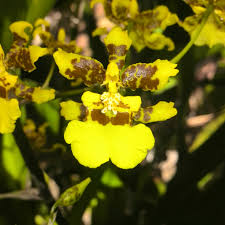
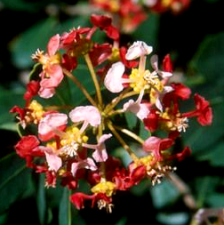
O. sphacelatum and Byrsonima lucida
Oncidium sphacelatum: Robert W. Pemberton. 2008. Pollination of The Ornamental Orchid Oncidium sphacelatum By the Naturalized Oil-Collecting Bee (Centris nitida) in Florida, Selbyana 29: 87-91, (full article available online). The author discovered an individual of Centris nitida visiting the native shrub Byrsonima lucida in a residential garden, and this particular bee had orchid pollinia stuck to its head. The source of the pollinia was apparently to be found in several hanging baskets of Oncidium sphacelatum in the same garden. The author then undertook a systematic program of observations of the orchid specimens over the course of their flowering. The main visitors to the flowers were the Centris nitida bees, and at least some of them did succeed in dislodging the pollinia of the flowers they visited, and in at least one case, carrying off the pollinia stuck to the front of its face. Seed set was observed, roughly one capsule per spike, in the orchids visited by the bees, while control specimens of O. sphacelatum, bagged to shield them from pollinators, did not produce any capsules, thus demonstrating that the capsules on the plants visited by the bees were not the result of self-pollination or apomixis. While Byrsonima lucida has pinkish flowers, and O. sphacelatum has bright yellow flowers, that is not necessarily how the bees see them! There may be more to this story. The bees apparently prefer flowers that resemble those of the Malpighiaceae, without being overly fussy about their color. At the very least, this report demonstrates that Centris nitida does visit Oncidium flowers even outside its normal habitat, in spite of the absence of any reward for doing so, and that these visits can result in pollination.
And that is certainly what we see today! Pink Oncidiums with a marked resemblance to the flowers of Malpighia glabra are indeed found together. There are similar observations involving at least some of the yellow Oncidium species (but most of these are now in other genera), and the Malpighian genus Stigmaphyllon (vines with yellow flowers that look very much like Oncidium, and usually known in the horticultural trade as "Orchid Vines"!).
The alert reader will have realized that each case of floral mimicry needs three players: the two flowers, and at least one pollinator whose behavior the two flowers are influencing. Plants, of course, don't move very far, but bees can and do move around. Climates change, habitats change, and so one of the three partners in this little dance must have sometimes disappeared. Some other pollinator, perhaps a different species of bee, may have come along and replaced the first bee species, and the newcomers may have had different flower preferences. We have to imagine that the co-evolution of flowers and the bees that pollinate them must have taken many unexpected and unknown turns over a very long period, coupled also with changes in climate, the uplift and later destruction of mountains, the changing course of rivers, and all the other components of a real tropical ecosystem.
The Players: It takes 3 to do the floral mimicry dance ~ ~ ~
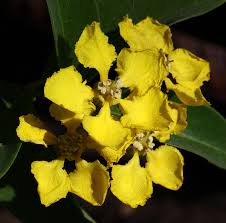
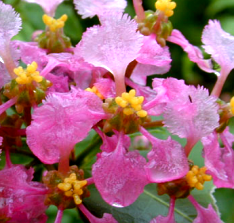
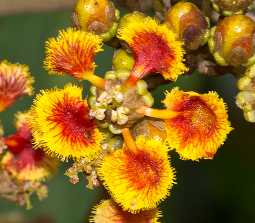
Stigmaphyllon ciliatum, Malpighia glabra, and Tetrapteris sp.
The model: Several genera in the Malpighiaceae have been implicated, including various species of Stigmaphyllon (yellow flowers), Malpighia (mostly pink flowers), and likely others, such as Tetrapteris (yellow flowers with orange or red highlights). Essentially the same floral architecture and colors occur in most species from this family, which consists mainly of tropical vines and trees.
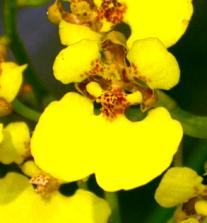
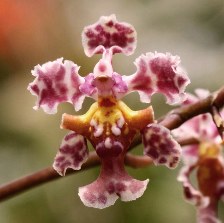
Rossioglossum ampliatum, Oncidium luridum
The mimic: Various species in the Oncidium alliance with yellow or pink/purple "dancing lady" flowers.
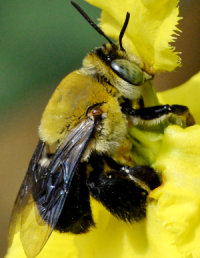
Centris nitida on a Stigmaphyllon flower. The bee is about 1/2" long, native to Central and South America, but now naturalized in parts of Florida as well.
The pollinator: Various species of cute little stingless bees. The genera Centris and perhaps Euglossa have been mentioned. They have been observed gathering oil and pollen from many species, but they seem to favor the Malpighiaceae. What do they do with the "floral oils" that they gather? Various theories have been advanced: Perhaps they use it to waterproof their nests? Or they use it as an ingredient in making little cakes of pollen? However, many of the Oncidium alliance flowers that are involved in this mimicry do not bear "floral oils", so the pollination strategy is often termed "rewardless" or even "deceitful" mimicry. The bees are fooled into visiting the rewardless orchid flowers, and may happen to carry away pollinia that could be deposited on the next orchid flower that they visit while looking for the real oil "rewards" offered by the similar flowers of the Malipighiaceae.
But the story of the co-evolution of flowers and their pollinators has been happening for millions of years, ever since the appearance of the angiosperms ("flowering plants"). What is new in this small chapter of the story, is that it no longer makes sense to reduce the evolutionary mechanisms to the case of one flower interacting with one pollinator. Rather, the existence of mimicry in flowers implies interactions of multiple flowers with individual pollinators.
For the problem of how we think about the species of the Oncidium alliance, how they are related to each other and what they should be called, the story of floral mimicry provides a possible explanation for the situation that led to the reorganization of the genus Oncidium: multiple species of flowers, each finding ways to exploit the tastes of the available pollinators. If multiple species, having a general similarity, were to interact with one or more species of pollinators that already had a preference for the flowers of the Malpighiaceae, it would be possible, after many cycles of mutation and natural selection, to end up with multiple Oncidium species that had each found a way to produce a mimic flower, good enough to fool the bees at least some of the time. Apart from their floral anatomy, these species would be no more closely related than any two randomly-chosen species from the Oncidium alliance, even though their flowers were very similar. Thus we could end up with a disparity between a classification based on floral anatomy, compared with a classification based on genetic similarity. And that is essentially what seems to have happened. The orchids are teaching us about how life works.
But science is always looking for the next question, the next complication. Here's one that might need to be considered: horizontal gene transfer. We know that many orchids in the Oncidium alliance can interbreed and produce fertile seedlings. They rarely are caught doing this in nature, but if it happened even once, under the right circumstances, we might end up with a natural population that got some of its floral mimicry genes from an unexpected source, some distantly related species that might not even exist today. Thus, if we posit the existence of even a little interbreeding over the long span of evolutionary history, we might have to rethink our conclusions. In fact, something like this is now believed to have happened during the course of human evolution: Neanderthals, Denisovans, and no one knows how many other early relatives of modern man that apparently interbred occasionally with "modern" humans in the very distant past. Individual genes in plants could well turn out to have origin stories of their own. In plants, also, there are "jumping genes", plasmids, chloroplast DNA, viruses, etc. that might have served as vectors to introduce genes from one plant into another.